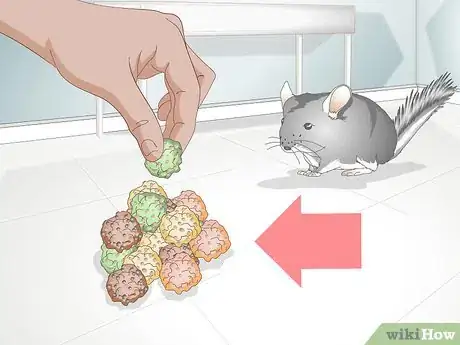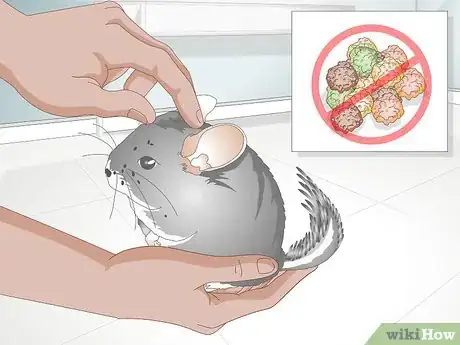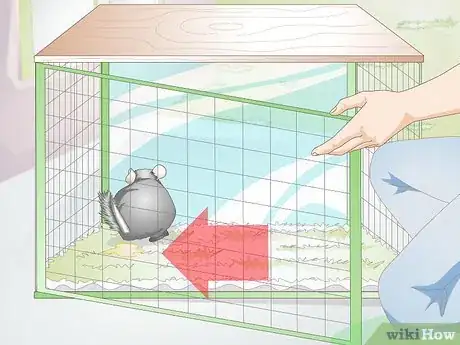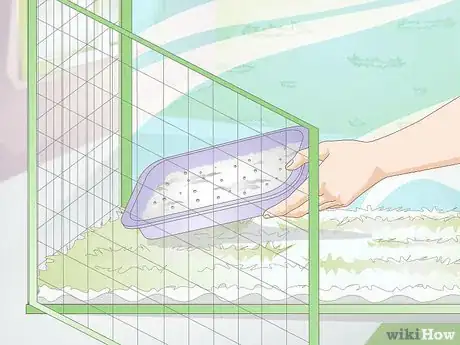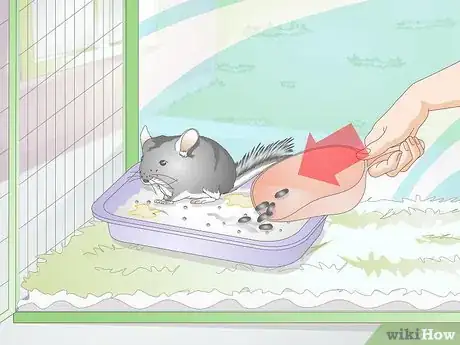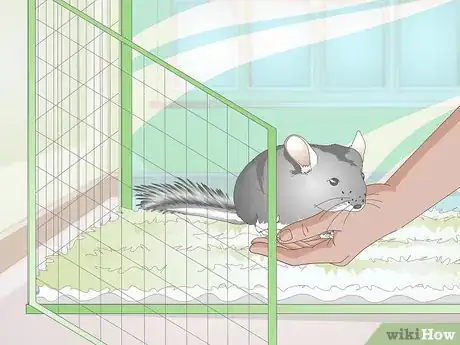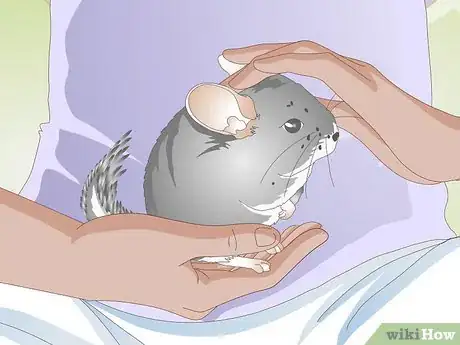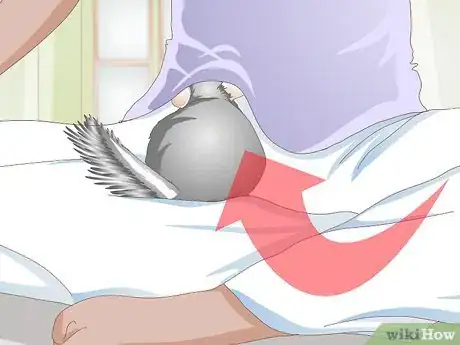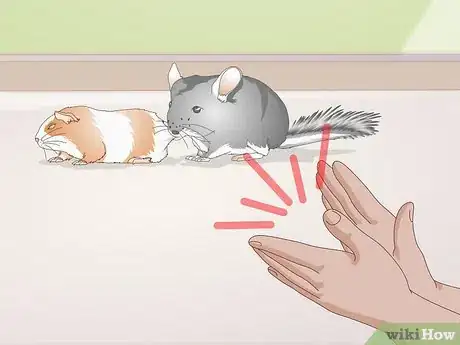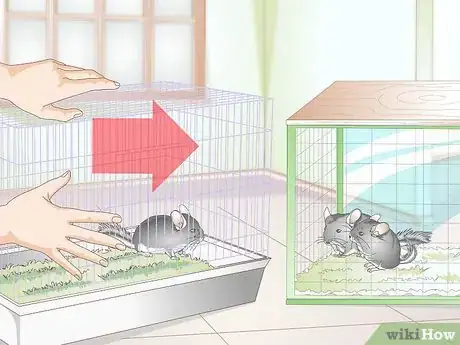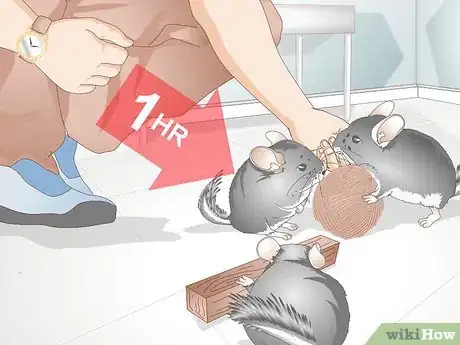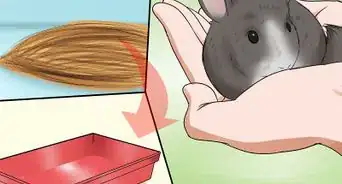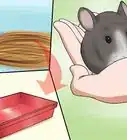This article was co-authored by Pippa Elliott, MRCVS. Dr. Elliott, BVMS, MRCVS is a veterinarian with over 30 years of experience in veterinary surgery and companion animal practice. She graduated from the University of Glasgow in 1987 with a degree in veterinary medicine and surgery. She has worked at the same animal clinic in her hometown for over 20 years.
wikiHow marks an article as reader-approved once it receives enough positive feedback. In this case, 80% of readers who voted found the article helpful, earning it our reader-approved status.
This article has been viewed 68,972 times.
Chinchillas are small rodents that are native to South America. They tend to be very energetic animals, but if you are patient enough to train one you'll find that they make great pets.[1] You won't be able to train a chinchilla the same way you train a dog, but you can teach your chinchilla basic tasks like climbing into your hand, discontinuing undesirable behavior, and using a litter box.
Steps
Training Your Pet to Come to You
-
1Choose the right treats. Treats are what will make or break this training exercise. You'll need to find a treat that your chinchilla responds well to, which may take some trial and error. You can use store-bought treats specifically made for chinchillas, or you can use household foods that are safe for chinchillas like raisins.
- Limit how many treats you give your chinchilla each day. Some treats are okay, but too many can lead to weight gain, tooth decay, and other health problems.
- Ask your vet if you're unsure how many treats your chinchilla should have. Your vet will most likely take your pet's size and weight into account.
-
2Present a treat. Your chinchilla won't come running the way a dog would, but with a little patience, your pet chinchilla will come to you and climb onto you in response to a treat. However, your chinchilla will need to feel safe and comfortable around you before you can advance to this level of training, which may take time and patience.[2]
- Hold the treat in one hand and lay your other open hand with your palm facing upwards.
- Your open hand should act as a stepping stone for your chinchilla to climb onto you and get the treat.
Advertisement -
3Try it without treats. Once your chinchilla learns to trust you and feels comfortable climbing into your hand for a treat, you may be able to coax your pet into your hand without food. You may even be able to perch your chinchilla on your shoulder and pet it, though this will take time and practice.[3]
Teaching Your Chinchilla to Use a Litter Box
-
1Note where your chinchilla urinates. Most chinchillas choose a designated spot in their cage to urinate in and return to that spot consistently. It may be obvious right away, or it may take some observation before you deduce where your pet urinates.[4]
- Look for wet spots on the wood chips or bedding inside your chinchilla's cage.
- If you don't feel a wet spot you may be able to deduce where there was urine by noting changes in color or texture on the bedding.
-
2Place the litter box where your pet urinates. If your chinchilla has established that spot as a designated urination spot, it will continue to use that location no matter what is covering the spot. Moving the box to that location teaches your pet that it should urinate in the litter on that location, and once it gets used to the litter box you can move it anywhere in the cage.
-
3Try moving your pet's feces into the litter box. Many chinchillas that urinate in a litter box have trouble learning to defecate there, but some chinchillas can and will learn to use the litter box to pass all of their wastes. Though there's no guarantee that your chinchilla will learn to defecate in the litter box, this is the only way to attempt that type of training.[5]
- Never scold or punish your chinchilla while you litter box train it.
- If your pet does not learn to defecate in the litter box, that's okay. Remember that all chinchillas are different and yours may simply have trouble with this task.
Nurturing a Calm and Trainable Chinchilla
-
1Let your chinchilla get comfortable with you. Before you can begin training your chinchilla, you'll need to build a rapport with your pet. This may take a few days, weeks, or even months, depending on your pet's personality and its previous experiences with people.
- Be sure to familiarize yourself with your chinchilla before attempting to introduce other friends or family members to your pet. Meeting too many people before a chinchilla feels comfortably "at home" with you could be stressful and confusing.
- Put your hand in the animal's cage from time to time, but don't reach for the chinchilla. Let it come to you while you hold your hand inside to build trust and establish familiarity.
- When your chinchilla does come to you, put your hand under its chin instead of on top of its head. This will help your pet feel less threatened as it gets to know you.
-
2Handle your pet often. The best way to begin training your chinchilla is to handle it as often as possible. This will help your pet become calmer and more comfortable around you, which, in turn, will make training much easier.[6]
- Chinchilla personalities are often solidified as early as 10 weeks of age. If you purchase an older chinchilla, be aware that it may not be as playful or easy to train as a younger animal.
- Some chinchillas are nervous, especially when they're first handled. If you pet your chinchilla and handle it often, though, it should become more playful and affectionate as it learns to trust you.
- Don't expect this change to happen overnight. Even if your chinchilla is young, it may take a while to build a rapport with your pet, and it may be fearful of being handled at first.
-
3Identify signs of fear. As you progress with your training, you may encounter some environmental stimulus that frightens your pet. This can potentially hinder your training progress and it may also cause your pet to become fearful in your home, so it's important to identify the cause of your pet's fear and address that stimulus accordingly.
- A frightened chinchilla will run or hide. If you and your chinchilla have bonded, it will most likely run to you and cling to you for protection.
- Any time your chinchilla does this, it is an indication that something in your home has frightened your pet. You may need to monitor the situation over time to determine the source if it's not immediately evident.
- Once you've identified the environmental stimulus that's frightening your chinchilla, you can remove it or modify it so that your pet feels safer in your home.
-
4Calm an anxious chinchilla. Some chinchillas are naturally skittish, while others develop a fear of people from insufficient handling during the animal's first weeks of life. Whatever the case may be, your pet may become frightened or anxious from time to time. When this happens, you'll need to calm the animal down if you hope to continue playing with and training your chinchilla.
- Hold your chinchilla by the base of the tail. If you grab the middle or end of the tail it will permanently fall off, as the chinchilla will believe it is in danger.
- While holding the base of your chinchilla's tail, use your other hand to support the animal's body from its underside. This will help your chinchilla feel safe and secure.
- Always handle your chinchilla while sitting with the animal's body close to whatever surface you're seated on. That way if it falls it can land safely.
-
5Stop a chinchilla from biting or barbering. Sometimes chinchillas bite people or other animals. A rambunctious chinchilla may also engage in barbering (pulling out another animal's hair), usually out of fear or anxiety. Any time your chinchilla bites (you or other animals) or attempts to pull the hair out of other chinchillas, you'll need to step in and stop that behavior.
- Make a loud, abrupt sound, like clapping your hands. Your chinchilla should become frightened and freeze in its tracks.
- Continue to interrupt undesirable behavior as soon as your chinchilla engages in it. The loud sound will distract your pet, and over time it should learn that the undesirable sound is related to its behavior.
Introducing Additional Chinchillas
-
1Isolate the animals. Keep your new chinchilla separate from your other chinchillas until the new animal has gotten a clean bill of health from your veterinarian. This will help prevent the spread of disease and give your new chinchilla time to adjust to your home.
-
2Introduce them with caution. You may think that your chinchilla is ready to meet your other pets because it is comfortable around you. However, introducing a new chinchilla to one or more existing chinchillas in your home is a tricky process that requires all animals involved to become comfortable with one another and to meet on neutral territory.
- Start out by placing the new animal's cage a few inches away from the cage your other chinchillas are in.
- They may need a few days to acclimate to one another's presence, and it's best to keep them in their respective cages during this time.
-
3Limit their interactions. When you do introduce your chinchillas face-to-face, you'll want to monitor them and make sure they get along okay. You'll also need to limit their time together until they adjust to one another.
- Introduce your chinchillas in a common area (like a separate room or hallway) so that neither animal will be territorial.
- Start out letting them play together for no more than an hour at a time, gradually increasing that time until several consecutive hours have passed and they've gotten along without incident.
- Some chinchillas may adjust to other chinchillas after a few days, while other chinchillas may take several months. Be patient and feel the situation out with your particular pets before letting them be together in the same cage.
Expert Q&A
-
QuestionCan you tame a chinchilla?
 Pippa Elliott, MRCVSDr. Elliott, BVMS, MRCVS is a veterinarian with over 30 years of experience in veterinary surgery and companion animal practice. She graduated from the University of Glasgow in 1987 with a degree in veterinary medicine and surgery. She has worked at the same animal clinic in her hometown for over 20 years.
Pippa Elliott, MRCVSDr. Elliott, BVMS, MRCVS is a veterinarian with over 30 years of experience in veterinary surgery and companion animal practice. She graduated from the University of Glasgow in 1987 with a degree in veterinary medicine and surgery. She has worked at the same animal clinic in her hometown for over 20 years.
Veterinarian You can certainly make friends with a chinchilla, given patience and the right attitude. Clicker training may also help as you can reward any signs of boldness by the chinchilla.
You can certainly make friends with a chinchilla, given patience and the right attitude. Clicker training may also help as you can reward any signs of boldness by the chinchilla. -
QuestionAre chinchillas litter box trainable?
 Pippa Elliott, MRCVSDr. Elliott, BVMS, MRCVS is a veterinarian with over 30 years of experience in veterinary surgery and companion animal practice. She graduated from the University of Glasgow in 1987 with a degree in veterinary medicine and surgery. She has worked at the same animal clinic in her hometown for over 20 years.
Pippa Elliott, MRCVSDr. Elliott, BVMS, MRCVS is a veterinarian with over 30 years of experience in veterinary surgery and companion animal practice. She graduated from the University of Glasgow in 1987 with a degree in veterinary medicine and surgery. She has worked at the same animal clinic in her hometown for over 20 years.
Veterinarian Yes, chinchillas are litter box trainable. Like most animals, they instinctively want to keep their toilet area separate from their eating and sleeping places. This means they readily learn to use an appropriate toileting area such as a litter box.
Yes, chinchillas are litter box trainable. Like most animals, they instinctively want to keep their toilet area separate from their eating and sleeping places. This means they readily learn to use an appropriate toileting area such as a litter box. -
QuestionCan chinchillas learn their name?
 Pippa Elliott, MRCVSDr. Elliott, BVMS, MRCVS is a veterinarian with over 30 years of experience in veterinary surgery and companion animal practice. She graduated from the University of Glasgow in 1987 with a degree in veterinary medicine and surgery. She has worked at the same animal clinic in her hometown for over 20 years.
Pippa Elliott, MRCVSDr. Elliott, BVMS, MRCVS is a veterinarian with over 30 years of experience in veterinary surgery and companion animal practice. She graduated from the University of Glasgow in 1987 with a degree in veterinary medicine and surgery. She has worked at the same animal clinic in her hometown for over 20 years.
Veterinarian Yes, chinchillas can learn their name, but the process will take time. You stand the best chance of success if you reward the chinchilla with a treat, so they associate their name with a tasty tidbit.
Yes, chinchillas can learn their name, but the process will take time. You stand the best chance of success if you reward the chinchilla with a treat, so they associate their name with a tasty tidbit.
Warnings
- Be careful what treats you use. Some people advise against giving your chinchilla nuts, seeds, fruits, and veggies. Some safer choices include rosehips (one or two daily, not whole), bee pollen (once a week), or oats (1-2 pieces 1-2 times a week).⧼thumbs_response⧽
References
- ↑ http://www.2ndchance.info/chinchilla.htm
- ↑ http://www.2ndchance.info/chinchilla.htm
- ↑ http://www.2ndchance.info/chinchilla.htm
- ↑ http://www.pethealthandcare.com/chinchillas/chinchillas-training.html
- ↑ http://www.pethealthandcare.com/chinchillas/chinchillas-training.html
- ↑ http://www.2ndchance.info/chinchilla.htm
About This Article
To train a chinchilla to come to you, start by getting its attention with a treat that it responds well to, such as store-bought treats or household foods that are safe for chinchillas, like raisins. Next, present your treat in one hand while holding your other hand open with your palm facing up. Then, wait for your chinchilla to climb into your hand to retrieve the treat. Once your chinchilla is comfortable coming to you, try holding your hand out and seeing if it will come to you without a treat to entice it. For more tips from our Veterinary reviewer, including how to stop a chinchilla from biting, keep reading!
